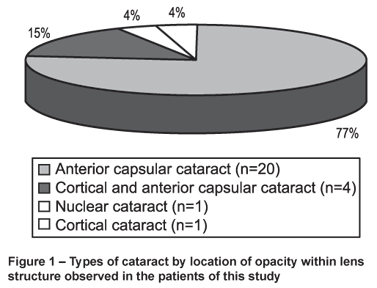OBJECTIVE: Typical antipsychotic drugs, mainly phenothiazines, have been associated with cataract formation for over forty years. Recently, there has been a concern about atypical antipsychotic drugs' potential for inducing this lenticular pathology. Accordingly, we sought to determine the cataract rate and other ocular side effects in patients on long-term therapy with antipsychotic drugs. METHOD: Eighty outpatients with DSM-IV diagnosis of schizophrenia from two settings who met pre determined inclusion criteria were submitted to an ophthalmological evaluation for ocular abnormalities with emphasis in the lens and cornea. They were divided into two groups: group 1 (n = 52) comprised patients who had been predominantly on typical antipsychotics for at least two years and group 2 (n = 28) patients who had been predominantly on atypical antipsychotics for at least two years. RESULTS: Cataract was found in 26 patients (33%) with predominance of anterior capsular cataract. The cataract rate among patients from group 1 (40%) was higher than among those from group 2 (18%). Visual acuity was reduced in 21 patients (26%). No changes were observed neither in the cornea nor in the retina. CONCLUSIONS: Patients using antipsychotic drugs should be submitted to a periodic ophthalmological evaluation.
Antipsychotic agents; Schizophrenia; Cataract; Risk factors; Polypharmacy





